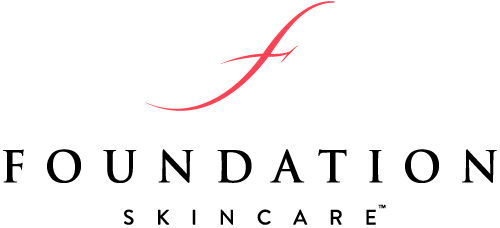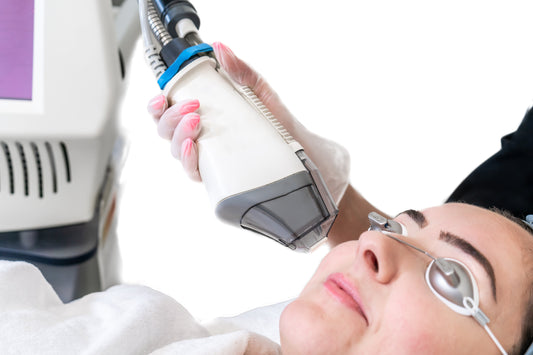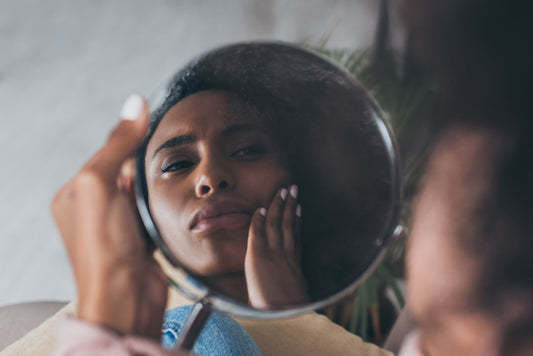If you’ve spent any time scrolling through skincare TikTok videos or Instagram Reels, you’ve probably come across the concept of skin cycling. Unlike many of the trends we see on social media, this is actually a dermatologist-backed skincare regime that can do wonders for your complexion. If you’re curious about implementing this routine (or just want to learn more), this is the ultimate guide to the specific steps to skin cycling.
What Is Skin Cycling?
Skin cycling refers to a four day evening routine cycle. It involves two days in a row of using products with more potent active ingredients, and then two rest days where the skin is able to repair itself. The idea behind this routine is that you’ll get the benefits of strong skincare products, but with a lower risk of irritation and inflammation.
The term “skin cycling” was coined by dermatologist Dr. Whitney Bowe (who posts popular educational skincare TikTok videos), and the concept has garnered a ton of interest on social media skincare communities this year.1 However, the general basis behind skin cycling isn’t exactly a new concept. Dermatologists and skincare experts have long recommended alternating skincare products to allow your skin to reset and to avoid causing irritation from retinoids, exfoliants, or other strong active ingredients.
That said, since the emergence of the skin cycling trend, skincare aficionados and newcomers alike have learned the benefits of allowing the skin to rest and repair after using more potent products.
How To Start Skin Cycling Process
Here’s a deeper look into the four night process, as well as what products you need for skin cycling.
Night 1: Exfoliation
During night one, you’ll exfoliate the skin to help clear away debris that can clog the pores and cause dullness. Exfoliation also allows the products you’re using in the morning and the following nights to work better, as they’ll be better able to penetrate the skin.
We typically suggest using a leave-on chemical exfoliant (which typically contains alpha hydroxy, beta hydroxy, and/or polyhydroxy acids), rather than a physically exfoliating cleanser or mask. Chemical exfoliants are generally kinder to the skin barrier, and they’ll work all night to get rid of dead skin cells and debris.
After cleansing with a gentle daily cleanser and drying the skin, apply your chemical exfoliant all over the face, neck, and chest. Allow it to absorb, and then follow up with a gentle moisturizer.
Night Renewal Cream
• Anti-aging defense, moisturizer
• Improves fine lines, skin texture
Night 2: Retinoid
Night two is focused on using either a prescription or over-the-counter retinoid, which is a vitamin A derivative that’s great for softening lines and wrinkles and fighting blemishes. The Foundation Skincare Night Renewal Cream is particularly well-suited for skin cycling, because it contains Granactive™ Retinoid, a highly-effective retinoid that has been shown to be less irritating than traditional prescription retinoids.2 It’s also packed with anti-aging peptides and hydrating ingredients to help promote a softer, radiant, and more youthful complexion.
Cleanse with a gentle cleanser and then pat the skin completely dry. Apply a thin layer of the retinoid all over the face, neck, and chest, and give it a few minutes to absorb. Follow up with a gentle moisturizer.
Nights 3 & 4: Recovery
In the final two nights of the skin cycling process, you’ll give your skin barrier a chance to repair and reset. This is an excellent time to use calming and hydrating products that are super gentle on the skin.
Two options worth considering are the Foundation Skincare Hyaluronic Acid Lotion (a hydrating and barrier-supporting lotion ideal for all skin types) and the Foundation Skincare Niacinamide Lotion (another option suitable for all skin types that’s particularly great for those targeting blemishes, redness, and/or pigmentation). Both of these products can be used at the same time if desired. Simply cleanse, apply the Niacinamide Lotion, and then finish off with the Hyaluronic Acid Lotion.
What Are The Benefits & Should Everyone Do It?
One of the major benefits of following the skin cycling routine is that it can help you achieve and maintain a healthy skin barrier (AKA the outermost layer of the skin). A strong, healthy skin barrier protects the body against environmental aggressors and also retains water. When the barrier is compromised, research shows there’s a higher risk of experiencing symptoms and conditions like acne, itchiness, redness, dryness, and rosacea.3
Unfortunately, many people end up unknowingly harming their skin barrier, often by over exfoliating or too frequently applying products that have a higher risk of causing irritation. The skin cycling method ensures your skin is getting an appropriate amount of exfoliation and treatment, while still giving it ample time to rest and repair in between for maximum barrier health.
Beyond skin barrier health, you’re still receiving the many benefits of using retinoids and exfoliants in your routine. This routine is great for anyone looking to minimize signs of aging, fade discoloration, fight acne, and improve uneven texture.
Luckily, skin cycling is suitable for virtually anyone, since you’re able to pick the exact products you’re using. For example, someone with sensitive skin can choose a gentler retinoid and a lower concentration exfoliant, while using soothing, hydrating products on rest nights.
FAQs
1. Can you use exfoliating cleansers while skin cycling?
A gentle daily exfoliating cleanser can still be used while skin cycling. It’s particularly appropriate for those with combination or oily skin (especially those prone to acne), but may be too harsh for those with dry or sensitive skin.
2. Can you use face masks when skin cycling?
Hydrating and calming masks are particularly great for rest nights, since they’re gentle on the skin. If you have an exfoliating mask you like, use that in place of your chemical exfoliant during your night one routine.
3. Can you dermaplane when skin cycling?
Since dermaplaning is a form of physical exfoliation, it would count as your exfoliation step during night one. Don’t follow up with a leave-on chemical exfoliant, as there’s a high risk of irritation.
4. What kind of results can you expect when skin cycling?
While this will differ from person to person, with consistent use over time, many people experience smoother texture and improved skin tone, fewer blemishes, and an overall more radiant complexion. You’ll also notice comfortable skin that both looks and feels healthy.





